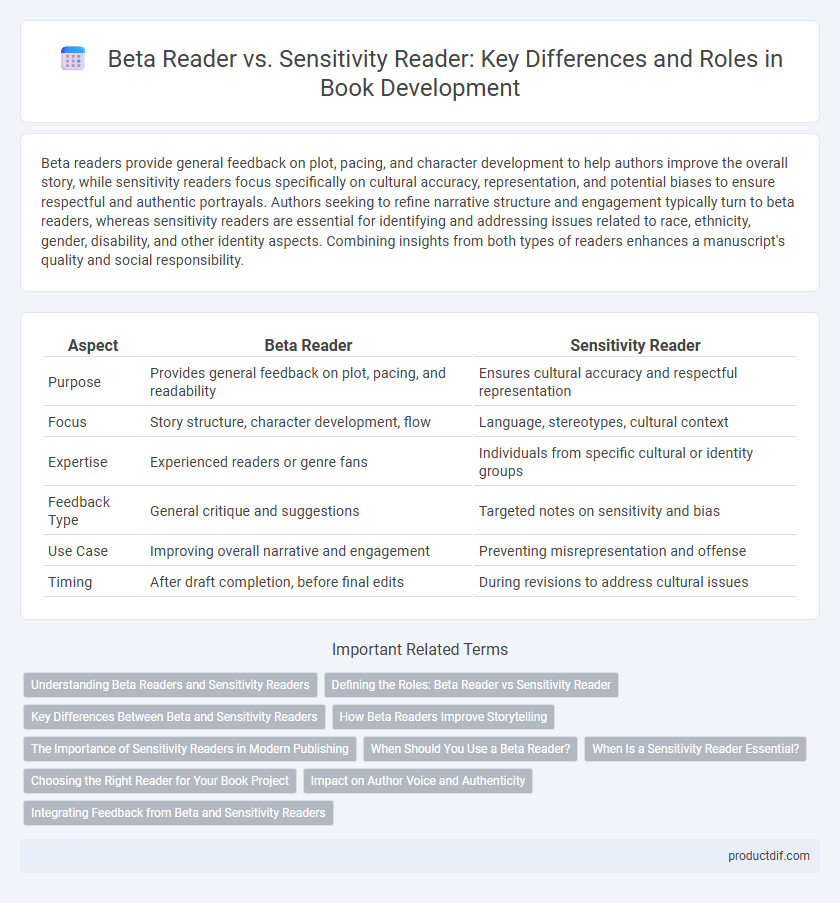Beta readers provide general feedback on plot, pacing, and character development to help authors improve the overall story, while sensitivity readers focus specifically on cultural accuracy, representation, and potential biases to ensure respectful and authentic portrayals. Authors seeking to refine narrative structure and engagement typically turn to beta readers, whereas sensitivity readers are essential for identifying and addressing issues related to race, ethnicity, gender, disability, and other identity aspects. Combining insights from both types of readers enhances a manuscript's quality and social responsibility.
Table of Comparison
| Aspect | Beta Reader | Sensitivity Reader |
|---|---|---|
| Purpose | Provides general feedback on plot, pacing, and readability | Ensures cultural accuracy and respectful representation |
| Focus | Story structure, character development, flow | Language, stereotypes, cultural context |
| Expertise | Experienced readers or genre fans | Individuals from specific cultural or identity groups |
| Feedback Type | General critique and suggestions | Targeted notes on sensitivity and bias |
| Use Case | Improving overall narrative and engagement | Preventing misrepresentation and offense |
| Timing | After draft completion, before final edits | During revisions to address cultural issues |
Understanding Beta Readers and Sensitivity Readers
Beta readers provide critical feedback on plot development, pacing, and character consistency, helping authors refine their manuscripts before publication. Sensitivity readers specialize in identifying and addressing potentially offensive or culturally inaccurate content, ensuring respectful and authentic representation. Understanding the distinct roles of beta readers and sensitivity readers is crucial for producing well-rounded and inclusive literature.
Defining the Roles: Beta Reader vs Sensitivity Reader
Beta readers primarily evaluate a manuscript's overall narrative flow, character development, and plot coherence, offering feedback from a general audience perspective. Sensitivity readers specialize in identifying and addressing potential issues related to cultural accuracy, representation, and harmful stereotypes to ensure respectful and authentic portrayal. Both roles are crucial for refining a book, with beta readers focusing on storytelling elements and sensitivity readers enhancing inclusivity and ethical responsibility.
Key Differences Between Beta and Sensitivity Readers
Beta readers evaluate a manuscript for plot coherence, character development, and overall readability, offering general feedback from a typical reader perspective. Sensitivity readers specifically assess the accuracy and respectful representation of diverse identities, cultures, and experiences to avoid stereotypes and potential harm. The key difference lies in beta readers focusing on narrative quality, while sensitivity readers prioritize cultural authenticity and inclusivity.
How Beta Readers Improve Storytelling
Beta readers provide crucial feedback on plot coherence, character development, and pacing, helping authors identify inconsistencies and narrative weaknesses. Their diverse perspectives enable writers to refine dialogue, strengthen emotional impact, and enhance overall readability. By highlighting areas that confuse or disengage readers, beta readers improve storytelling quality before publication.
The Importance of Sensitivity Readers in Modern Publishing
Sensitivity readers play a crucial role in modern publishing by ensuring cultural accuracy, preventing stereotypes, and fostering inclusivity in books. Unlike beta readers who primarily focus on plot, pacing, and character development, sensitivity readers specialize in identifying potentially offensive or inaccurate portrayals related to race, ethnicity, gender, disability, and other marginalized identities. Their expertise helps authors and publishers produce respectful and authentic content, improving representation and audience engagement.
When Should You Use a Beta Reader?
A Beta Reader is essential during the late drafting stage of a book, offering feedback on plot coherence, character development, and pacing to ensure the story resonates with target readers. They help identify inconsistencies, confusing sections, and areas that lack emotional impact, providing an outside perspective before final editing. Use Beta Readers when you need honest reader reactions to refine the manuscript's overall appeal and narrative flow.
When Is a Sensitivity Reader Essential?
A sensitivity reader is essential when a book addresses cultures, identities, or experiences outside the author's own background to ensure accurate and respectful representation. Unlike beta readers who focus on story structure and overall readability, sensitivity readers identify potential stereotypes, cultural inaccuracies, or offensive content, helping to prevent unintentional harm. Their expertise is crucial for authors aiming to create authentic, inclusive narratives that resonate respectfully with diverse audiences.
Choosing the Right Reader for Your Book Project
Choosing the right reader for your book project depends on your manuscript's specific needs; beta readers provide general feedback on plot, pacing, and character development, while sensitivity readers focus on cultural accuracy and avoiding stereotypes. Authors aiming for diverse representation and authenticity benefit most from sensitivity readers who ensure respectful and accurate portrayals. For comprehensive improvement, combining both readers can enhance the overall quality and inclusivity of your book.
Impact on Author Voice and Authenticity
Beta readers provide feedback on plot, pacing, and character development, helping authors refine narrative flow while preserving their unique voice. Sensitivity readers focus on cultural accuracy and representation, ensuring depictions are authentic without diluting the author's intent. Balancing insights from both types of readers enhances the story's credibility and maintains the author's authentic voice.
Integrating Feedback from Beta and Sensitivity Readers
Integrating feedback from beta readers and sensitivity readers involves carefully balancing narrative flow with cultural accuracy to enhance both readability and authenticity. Beta readers provide insights into plot coherence, character development, and pacing, while sensitivity readers focus on identifying and correcting potential cultural inaccuracies, stereotypes, or offensive content. Synthesizing these perspectives ensures a well-rounded manuscript that resonates effectively with diverse audiences while maintaining compelling storytelling.
Beta Reader vs Sensitivity Reader Infographic

 productdif.com
productdif.com